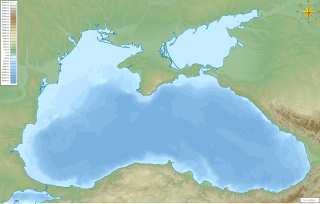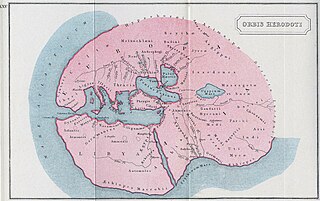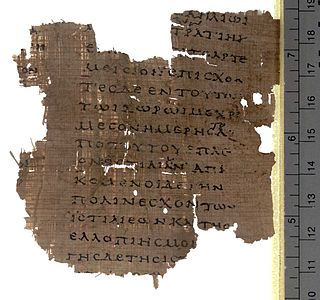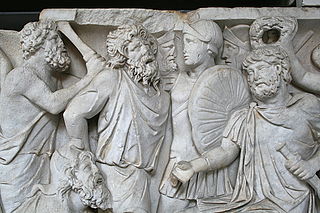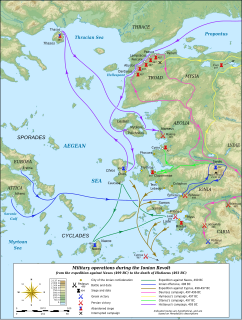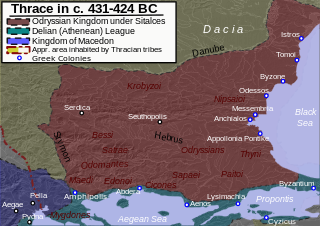| European Scythian campaign of Darius I | |||||||
|---|---|---|---|---|---|---|---|
 Map of the European Scythian campaign of Darius I | |||||||
| |||||||
| Belligerents | |||||||
| Achaemenid Empire Ionian allies | Royal Scythians Allies: Tauri Agathyrsi Neuri Androphagi Melanchlaeni Budini & Gelonians Sauromatae Getae | ||||||
| Commanders and leaders | |||||||
| Darius I Megabazus Ionian allies: Miltiades the Athenian Strattis of Chios Histiaeus of Miletus Aiaces of Samos Coes of Mytilene Laodamas of Phocaea Aristagoras of Cymae Daphnis of Abydos Hippoclus of Lampsacus Herophantus of Parium Metrodorus of Proconnesus Aristagoras of Cyzicus Ariston of Byzantium | Idanthyrsus Scopasis Unnamed others | ||||||
| Units involved | |||||||
| Mostly infantry; [1] 80,000 after Darius' return to Asia (Herodotus) [2] | Unknown number of Scythian horsemen [3] | ||||||
The European Scythian campaign of Darius I was a military expedition into parts of European Scythia by Darius I, the king of the Achaemenid Empire, in 513 BC. [4] The Scythians were an East Iranian-speaking people who had invaded Media, revolted against Darius and threatened to disrupt trade between Central Asia and the shores of the Black Sea as they lived between the Danube and Don Rivers and the Black Sea. [5] [6] The campaigns took place in parts of the Balkans and Eastern Europe proper, while principally in what is modern-day Ukraine and southern Russia.

Scythia was a region of Central Eurasia in classical antiquity, occupied by the Eastern Iranian Scythians, encompassing Central Asia and parts of Eastern Europe east of the Vistula River, with the eastern edges of the region vaguely defined by the Greeks. The Ancient Greeks gave the name Scythia to all the lands north-east of Europe and the northern coast of the Black Sea.

The Achaemenid Empire, also called the First Persian Empire, was an empire based in Western Asia founded by Cyrus the Great. Ranging at its greatest extent from the Balkans and Eastern Europe proper in the west to the Indus Valley in the east, it was larger than any previous empire in history, spanning 5.5 million square kilometers. Incorporating various peoples of different origins and faiths, it is notable for its successful model of a centralised, bureaucratic administration, for building infrastructure such as road systems and a postal system, the use of an official language across its territories, and the development of civil services and a large professional army. The empire's successes inspired similar systems in later empires.
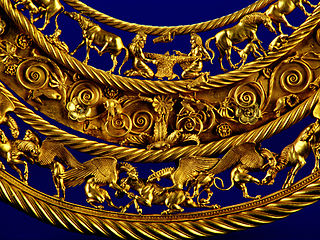
The Scythians, also known as Scyth, Saka, Sakae, Sai, Iskuzai, or Askuzai, were Eurasian nomads, probably mostly using Eastern Iranian languages, who were mentioned by the literate peoples to their south as inhabiting large areas of the western and central Eurasian Steppe from about the 9th century BC up until the 4th century AD. The "classical Scythians" known to ancient Greek historians, agreed to be mainly Iranian in origin, were located in the northern Black Sea and fore-Caucasus region. Other Scythian groups documented by Assyrian, Achaemenid and Chinese sources show that they also existed in Central Asia, where they were referred to as the Iskuzai/Askuzai, Saka, and Sai, respectively.
Contents
- The campaign
- Towards the end of the campaign
- Further reasons behind the invasion past the Danube
- Date of the invasion
- Aftermath
- Assessment
- See also
- References
- Sources
- Further reading
The Scythians managed to avoid a direct confrontation with the Persian army due to their mobile lifestyle and lack of any settlement (except Gelonus), while the Persians suffered losses due to the Scythians' scorched earth tactic. However, the Persians conquered much of their cultivated lands and damaged their allies, forcing the Scythians to respect the Persian force. Darius halted the advance to avoid further losses, and built a defence line.
Gelonus was, according to Herodotus, the capital of the Gelonians.

A scorched-earth policy is a military strategy that aims to destroy anything that might be useful to the enemy while it is advancing through or withdrawing from a location. Any assets that could be used by the enemy may be targeted, for example food sources, water supplies, transportation, communications, industrial resources, and even the local people themselves.

